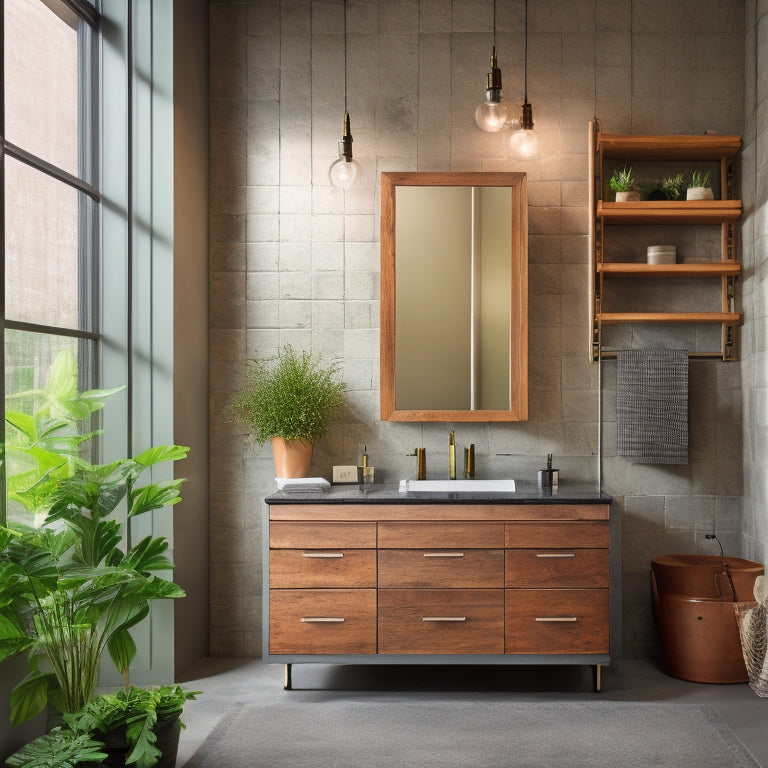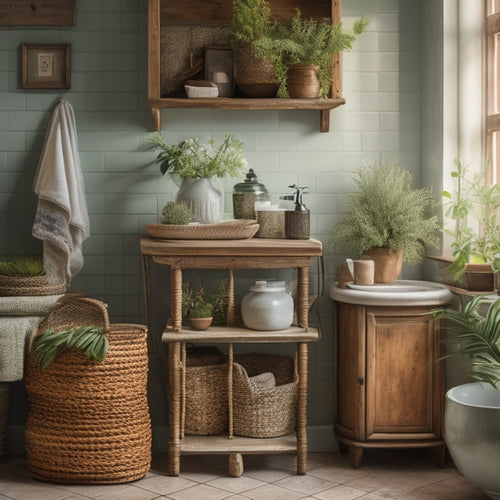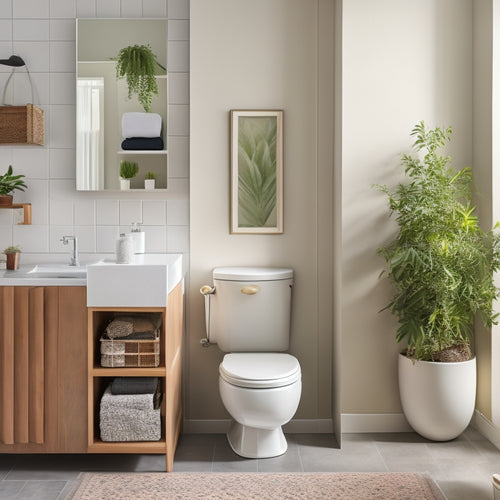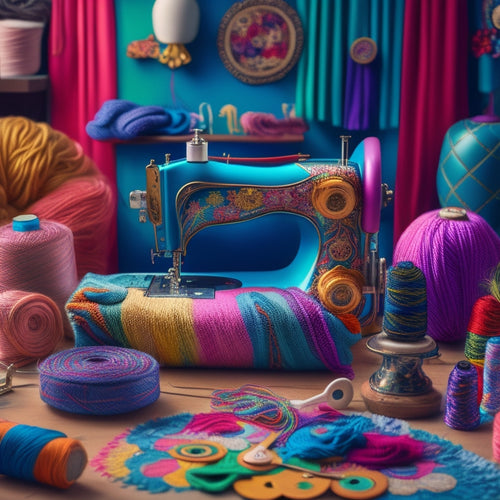
Eco-Friendly Industrial Bathroom Cabinet Materials
Share
You're specifying eco-friendly industrial bathroom cabinet materials that not only reduce your carbon footprint but also promote a healthier indoor environment and support sustainable manufacturing practices. For a sustainable option, choose biodegradable composites made from renewable resources like bamboo and sugarcane, or durable materials like reclaimed wood and low-carbon steel that sequester carbon. Opt for recycled glass and low-carbon concrete with low embodied energy to minimize greenhouse gas emissions. With a focus on high recycled content, sustainable manufacturing, and low VOC emissions, you'll be well on your way to creating an eco-friendly industrial bathroom - and there's even more to take into account when making your selection.
What You Need to Know
- Choose sustainable materials like bamboo, reclaimed wood, and low-carbon steel that minimize greenhouse gas emissions and support a healthier planet.
- Opt for materials with high recycled content to reduce landfill waste, conserve natural resources, and promote a circular economy.
- Prioritize low-VOC emission materials to improve indoor air quality and ensure a safe and healthy bathroom environment.
- Select durable, moisture-resistant materials like solid core materials, bamboo, or recycled paper-based products to prevent water damage and reduce waste.
- Consider space-efficient designs that maximize storage options and utilize vertical space to create organized and clutter-free industrial bathrooms.
Reduced Carbon Footprint Guaranteed
You're likely looking for bathroom cabinet materials that not only minimize environmental harm but also guarantee a reduced carbon footprint.
To achieve this, you'll want to focus on low-carbon material options that prioritize sustainability. By choosing materials with a sustainable supply chain, you'll greatly reduce your bathroom's ecological impact.
Furthermore, durable materials like bamboo and reclaimed wood are ideal eco-friendly options, offering resilience in damp environments and requiring minimal maintenance.
Low-Carbon Material Options
When designing an eco-friendly bathroom, selecting low-carbon material options is crucial to minimizing environmental impact. You'll want to focus on materials that reduce greenhouse gas emissions and promote a healthier planet.
One approach is to opt for biodegradable composites, which are made from renewable resources such as bamboo, sugarcane, or potato starch. These materials can replace traditional plastics and reduce waste.
Another option is to choose materials with low embodied energy, such as recycled glass or low-carbon concrete. These materials require less energy to produce, resulting in a lower carbon footprint.
Additionally, incorporating wood corner shower shelves space-maximizing designs can also contribute to a more eco-friendly bathroom by utilizing often-wasted corners and reducing clutter.
You can also consider materials that sequester carbon, like reclaimed wood or low-carbon steel. These materials absorb more carbon dioxide than they emit, helping to offset your bathroom's carbon footprint.
Additionally, look for materials with certifications like FSC or Cradle to Cradle, which guarantee the materials meet rigorous environmental standards.
Sustainable Supply Chain
Selecting eco-friendly bathroom cabinet materials is just the first step; verifying they're sourced from a sustainable supply chain is equally important. You want to make certain the materials you've chosen aren't contributing to environmental or social issues elsewhere in the production process.
| Aspect | Why it Matters | Your Action |
|---|---|---|
| Supply Chain Transparency | You can't manage what you don't measure. | Request suppliers provide detailed information on their sourcing and production practices. |
| Ethical Sourcing | Confirm materials aren't sourced from environmentally damaging or exploitative practices. | Look for certifications like FSC or Fair Trade, and audit suppliers regularly. |
| Local Sourcing | Reduce transportation emissions and support local economies. | Prioritize suppliers with local operations or those using low-carbon transportation methods. |
Low VOC Emission Guarantee
You're probably aware that volatile organic compounds (VOCs) can negatively impact indoor air quality.
When choosing eco-friendly bathroom cabinet materials, you'll want to look for options that guarantee low VOC emission rates, ensuring vapour emission reduction and safe air quality in your bathroom.
Vapour Emission Reduction
One essential aspect of eco-friendly bathroom cabinet materials is vapour emission reduction, which directly impacts indoor air quality.
You're likely aware that volatile organic compounds (VOCs) in traditional materials can contribute to poor air quality, negatively affecting your health and wellbeing. By choosing materials with low VOC emissions, you're taking a vital step towards sustainable design and a healthier indoor environment.
Incorporating shelves with baskets in your bathroom can also promote a sense of order and calmness, much like bathroom storage solutions. This is especially important in bathrooms, where clutter can quickly accumulate and make the space feel overwhelming.
When selecting eco-friendly bathroom cabinet materials, look for those with low VOC emission guarantees.
These materials have been engineered to minimize the release of harmful chemicals, ensuring better air quality and a safer space for you and your loved ones. This is particularly important in bathrooms, where moisture and humidity can exacerbate VOC emissions.
Opting for low VOC emission materials not only improves air quality but also supports a more sustainable design approach.
By making informed choices, you're contributing to a healthier, more environmentally conscious future.
Safe Air Quality
Vapour emission reduction in bathroom cabinets is essential, and a low VOC emission assurance guarantees safe air quality. You want to breathe easily and freely in your bathroom, knowing the air is pure and healthy. A low VOC emission assurance guarantees that your bathroom cabinets won't contribute to indoor air pollution. This is especially important in bathrooms, where moisture and humidity can exacerbate the negative effects of VOCs.
Additionally, maintaining a clutter-free space with woven baskets and clear storage bins can also contribute to a healthier environment. By keeping bathroom essentials organized, you can reduce stress and anxiety, creating a more peaceful space.
To further enhance air quality, consider combining low-VOC cabinets with air purification systems or indoor plants. These natural air purifiers can remove impurities and toxins from the air, creating a healthier environment. By choosing bathroom cabinets with a low VOC emission assurance, you're taking an essential step towards maintaining safe air quality.
When selecting eco-friendly bathroom cabinet materials, look for products that meet strict VOC emission standards. This guarantees that your bathroom cabinets won't release harmful chemicals into the air, promoting a healthier space that's free from pollutants.
Recycled Stainless Steel Option
You'll appreciate the recycled stainless steel option for its durable material properties, which resist corrosion and withstand heavy use.
This eco-friendly material also boasts a sustainable manufacturing process, reducing waste and conserving natural resources.
Additionally, opting for recycled stainless steel aligns with the trend of maximizing vertical storage vertical space and creating organized environments, as discussed in bathroom design.
Durable Material Properties
Durability is a hallmark of eco-friendly bathroom cabinets, and recycled stainless steel embodies this quality. You want your bathroom cabinets to withstand the humid environment and heavy use, and recycled stainless steel delivers. Its durability is rooted in its resistance to corrosion, scratches, and dents.
| Property | Description | Benefit |
|---|---|---|
| Corrosion Resistance | Resists damage from moisture and chemicals | Long-lasting performance |
| Scratch Resistance | Withstands daily wear and tear | Easy maintenance |
| Dent Resistance | Retains its shape and appearance | Uncompromising durability |
| Weather Resistance | Performs well in humid and wet conditions | Ideal for bathroom use |
Recycled stainless steel's weather resistance benefits are particularly significant in bathroom settings, where moisture and humidity are prevalent. Additionally, its maintenance longevity means you won't need to worry about frequent repairs or replacements. With recycled stainless steel, you can enjoy the freedom to focus on more important things, knowing your bathroom cabinets will stand the test of time.
Sustainable Manufacturing Process
One essential aspect of eco-friendly bathroom cabinets is the sustainable manufacturing process of recycled stainless steel.
As you investigate eco design options, you'll want to evaluate the environmental impact of production. A lifecycle assessment of recycled stainless steel reveals significant reductions in greenhouse gas emissions, energy consumption, and water usage compared to traditional steel production.
In the manufacturing process, recycled stainless steel is melted down and reformed into new sheets, reducing the need for virgin materials.
This closed-loop system minimizes waste and conserves natural resources. The resulting cabinets not only boast exceptional durability but also contribute to a more sustainable future.
Moisture-Resistant Material Priority
When designing an eco-friendly bathroom cabinet, you need to prioritize moisture-resistant materials to prevent water damage.
You'll want to choose durable core materials that can withstand the humid environment, ensuring your cabinet remains functional and intact.
Water Damage Prevention
Your bathroom cabinet's worst enemy is water, and its destructive power can lead to costly repairs, mold growth, and even structural damage.
To prevent water damage, you must prioritize moisture-resistant materials that can withstand the humid bathroom environment. Look for materials with built-in water resistance, such as those treated with waterproof coatings or infused with water-repellent properties.
Proper material sealing is essential in mold prevention. Make certain that all joints and seams are sealed with a waterproof adhesive to prevent water infiltration.
Additionally, consider using materials with inherent mold-resistant properties, such as those made from recycled plastic or plant-based composites. These materials are less prone to mold growth and can reduce the risk of water damage.
When selecting materials, consider their water absorption rates, durability, and resistance to warping or swelling.
By choosing materials that can withstand water exposure, you can prevent costly repairs and guarantee your bathroom cabinet remains safe and functional.
Prioritize water damage prevention to maintain a healthy, mold-free bathroom environment.
Durable Core Materials
A solid core material is the backbone of a durable bathroom cabinet, and it's vital to prioritize moisture-resistant options to guarantee a long-lasting and healthy environment.
You'll want to opt for materials that can withstand the humid conditions typical in industrial bathrooms. Medium-density fiberboard (MDF) and plywood are popular choices, but they can be prone to water damage. Instead, consider eco-friendly alternatives like bamboo or recycled paper-based products. These materials aren't only moisture-resistant but also sustainable and environmentally friendly.
When selecting a core material, it's important to pair it with eco-friendly finishes that promote a healthy environment. Look for finishes that are free from volatile organic compounds (VOCs) and formaldehyde.
Modular designs can also enhance the durability of your bathroom cabinet. By using modular components, you can easily replace damaged parts, reducing waste and the environmental impact of replacement.
Higher Recycled Content Ratio
You'll want to contemplate bathroom cabinet materials with a higher recycled content ratio, as this directly impacts the environmental sustainability of your eco-friendly design.
Look for materials with a high post-consumer recycled content, which reduces the amount of waste sent to landfills and conserves natural resources.
A higher recycled content ratio also decreases the carbon footprint of your bathroom renovation.
Post-Consumer Recycled Content
Bathroom cabinets made with post-consumer recycled content boast a higher recycled content ratio, making them an attractive option for eco-conscious homeowners.
You'll find that these cabinets are constructed from materials that would otherwise end up in landfills, reducing waste and conserving natural resources. Recycled plastics, for instance, can be converted into durable, water-resistant cabinet components. Upcycled wood, another common post-consumer material, can be repurposed into sturdy shelves and drawers.
When you choose cabinets with post-consumer recycled content, you're supporting a circular economy that values sustainability. This approach reduces the demand for virgin materials, decreasing the environmental impact of resource extraction and processing.
As a result, you'll not only be enjoying a more eco-friendly bathroom, but you'll also be contributing to a greener future. By selecting cabinets with a higher recycled content ratio, you're making a conscious decision to minimize waste and promote environmental stewardship.
Frequently Asked Questions
Can Eco-Friendly Cabinets Be Used in High-Traffic Industrial Bathrooms?
You can confidently specify eco-friendly cabinets for high-traffic industrial bathrooms, as long as they meet stringent sustainability standards and boast impressive durability ratings, ensuring a harmonious blend of environmental responsibility and functional resilience.
Are Eco-Friendly Materials More Expensive Than Traditional Options?
When assessing your wallet's welfare, you'll find that eco-friendly materials often come with a slightly higher upfront cost, but they'll ultimately offset expenses through long-term sustainability benefits, making the investment a financially savvy choice.
Do Eco-Friendly Cabinets Come With a Longer Warranty Period?
You'll find that many eco-friendly products, including cabinets, often come with extended warranties due to their durability and sustainability benefits, which are backed by material certifications, providing you with peace of mind and protection for your investment.
Can I Customize Eco-Friendly Cabinets to Fit My Bathroom Design?
You're the expert chef of your bathroom design, and eco-friendly cabinets are the secret ingredient. You can whip up a customized blend of sustainable design and cabinet finishes that fit your unique taste, ensuring a perfect harmony of form and function.
Are Eco-Friendly Cabinets More Prone to Water Damage?
You're right to wonder if eco-friendly cabinets are more prone to water damage. Fortunately, many sustainable finishes offer excellent moisture resistance, so you can enjoy peace of mind and a clear conscience in your bathroom oasis.
Explore More
By choosing eco-friendly industrial bathroom cabinet materials, you're not only reducing your carbon footprint but also creating a healthier environment for users. For instance, a recent hospital renovation in California opted for recycled stainless steel cabinets, reducing waste by 75% and earning a LEED Gold certification. By prioritizing low-VOC emissions, moisture-resistant materials, and higher recycled content ratios, you can create a sustainable and hygienic space that benefits both people and the planet.
Related Posts
-

Unique Vintage Bathroom Storage Furniture
Unique vintage bathroom storage furniture seamlessly blends timeless elegance with practical functionality, altering ...
-

Over-The-Toilet Storage for Modern Homes
Over-the-toilet storage is a smart solution for modern homes, maximizing vertical space and enhancing organization. Y...
-

Get Your Quirky Designs Now
Express your individuality with vibrant, one-of-a-kind designs that celebrate self-expression and quirky humor. Disco...


